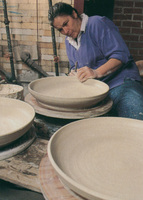
The handcraft tradition in West Virginia, an integral part of the mountain culture, is rooted in history and necessity. The seeds of our state’s arts and crafts tradition were sown when the Appalachian region was settled in the late 1700s and early 1800s, primarily by the English, Irish, Scotch, and Germans.
Many decorative arts, such as painting, drawing, and print-making, came to this country from Britain and other parts of Europe, but in the early days were practiced primarily by the upper classes who settled along the coast. The more practical craft skills brought over the mountains by Appalachia’s immigrants flourished through necessity; knowing them meant survival. Practically everything the early settlers had, they made with their hands. Craftsmanship was a strong factor in the work of these early citizens of Western Virginia, but practicality was uppermost in the makers’ minds. This is not to say that the early handcrafts were not beautiful, for they often were. Both elements, functionality and beauty, combined to make an object of pleasure and satisfaction for the maker and the user. Blacksmiths forged essential items, including tools and hardware, but they also formed decorative fireplace tools and wrought iron candlesticks. Tinsmiths fashioned kitchen utensils, including spoons, forks, and cups, as well as delicately pierced lanterns. Leathersmiths tanned hides and made carrying sacks, harnesses, saddle bags, belts, and even the blacksmiths’ bellows; but they also used their talents to make beautiful vests and jackets.
Craftsmen turned natural materials found or grown in abundance into a wide variety of products. They cut timber to make furniture, fences, and log cabins and outbuildings. They whittled wood into bowls, cooking utensils of all types, musical instruments, gun stocks, and toys for their children. They split oak into thin strips, soaked them, and wove them into baskets. Brooms were made of straw or corn husks, gathered into a bundle and tied to a handle. Vegetables and nuts were boiled to make dyes. Carding wool, spinning the yarn, and weaving it into cloth were a part of the pioneer woman’s work. Linen was made of the fibers of flax, whose seed was milled into linseed oil.
The needle skills brought to the mountains by the women settlers provided clothing, table linens, and blankets. Often made of scraps from worn-out clothes or left-over cloth, padded with worn-out blankets or cotton batting, and closely stitched together in layers, their quilts evolved into works of art, as decorative as they were practical. Today’s most precious heirlooms are the woven coverlets and patchwork or applique quilts of that era.
Soap was made by boiling water, lye, and grease. The mixture was boiled until it dissolved and became smooth, then it was poured into a shallow pan, allowed to harden, and cut into cakes of soap. The lye itself was made from the drippings that result from pouring water over wood ashes. Candles were fashioned from tallow or beeswax and hardened in metal forms. Coopers bent wood into barrels for storage of grains and whiskey.
No doubt in some places handcrafts have been practiced without interruption since their arrival on our shores, but by 1890 many of the old ways were abandoned in much of America. However, in West Virginia, as in much of Appalachia, these skills persisted as part of daily life longer than in other areas because of the relative isolation of the region.
In the 1960s, another wave of immigrants to West Virginia, representing the counterculture back-to-the-land movement, inadvertently helped to rescue many endangered crafts and old ways of living. These were young people, often from middle-class backgrounds. At the time they came to West Virginia seeking cheap land and a simpler lifestyle, they thought they were joining the mountain people’s lifestyle. Instead, by becoming students of the Appalachian culture, they helped to save much of its handcraft tradition from extinction.
In the late 1960s and early 1970s, handcraft cooperatives were formed across West Virginia as economic development projects during the War on Poverty. Often formed under the auspices of various state or federal agencies, the co-ops encouraged artisans to market their handcrafts collectively. The Mountain State Art & Craft Fair, started in 1963 as part of West Virginia’s Centennial celebration, showcased the work of many of these craft cooperatives as well as that of individual artisans. The movement flourished with the encouragement of the state Commerce Department and later the Department of Culture and History. Today Tamarack, an arts and crafts showcase on the West Virginia Turnpike at Beckley, serves as a sales outlet for many artisans, as do MountainMade Foundation and other retailers. There is a robust handcrafts community in West Virginia, producing wares of excellent workmanship. These crafts sell at premium prices, often well above the cost of equivalent manufactured items, as yesterday’s necessities ironically are transformed into the luxuries of today.
This Article was written by Carter T. Seaton
Last Revised on August 14, 2012
Sources
Eaton, Allen H. Handicrafts of the Southern Highlands. New York: Dover Publications, 1973.
Law, Rachel N. & Cynthia W. Taylor. Appalachian White Oak Basketmaking. Knoxville: University of Tennessee Press, 1991.
Cite This Article
Seaton, Carter T. "Handcrafts." e-WV: The West Virginia Encyclopedia. 14 August 2012. Web. 26 July 2024.



Comments?
There aren't any comments for this article yet.
Click here to read and contribute to the discussion →